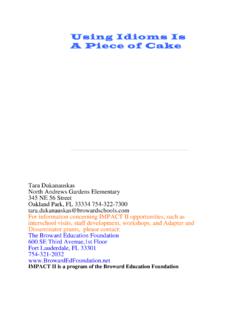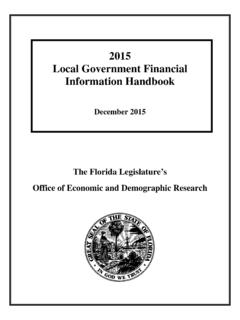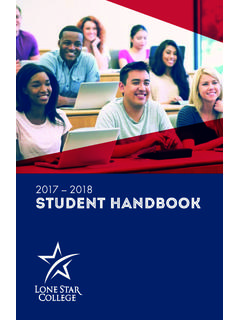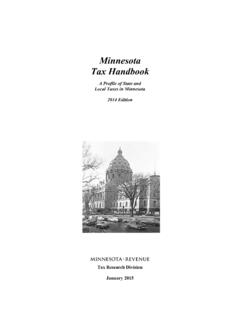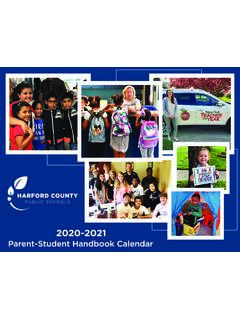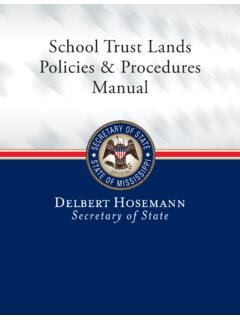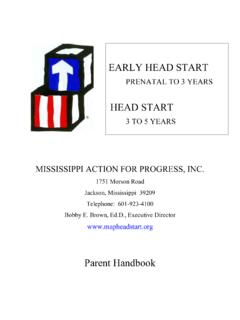Transcription of Mary Alice Rowley Forest Glen Middle School 6501 Turtle ...
1 Mary Alice Rowley Forest Glen Middle School 6501 Turtle Run Blvd. Coral Springs, FL 33067 754-322-3400 For information concerning IMPACT II opportunities, such as interschool visits, staff development, workshops and Adapter and Disseminator grants, please contact: The Broward Education Foundation 600 SE Third Avenue, 1st Floor Fort Lauderdale, FL 33301 754-321-2032 IMPACT II is a program of the Broward Education Foundation GOALS p. 1 OBJECTIVES p. 2 STATE STANDARDS p. 3 - 4 LESSON PLANS p. 5 31 INTRODUCTION p. 5 7 RESTAURANT CAREERS p. 8 FORMAL MEALS & TABLE SETTINGS p. 9 11 RESTAURANT VOCABULARY p. 12 13 MENU MATH ACTIVITIES p.
2 14 19 MENUS p. 20 MENU SELECTIONS p. 21 - 23 CREATING RESTAURANTS & MENUS p. 24 - 26 ESSAY WRITING p. 27 LITERATURE & VIDEOS p. 28 - 30 RESTAURANT FIELD TRIP p. 31 EVALUATION p. 32 - 33 RESOURCES p. 34 - 35 BIBLIOGRAPHY p. 36 - 37 1 In today s society, with families fractured through divorce and separation, problems with the economy, and the elimination of Home Economics in most Middle schools, students are not exposed to as many social situations as in years past. Other than fast-food establishments, most Middle School students have had little or no experience with eating in a restaurant. They don t understand the rules of etiquette while dining out, and many phrases on a menu are completely unfamiliar to them. In addition, the concepts of computing tax and tip need to be learned. With employers now having the luxury of being selective about whom they hire, social graces are something students need to master in order to succeed in the workplace, and, more importantly, to function in society.
3 The purpose of this project is to teach students the life skills they need when dining in public. The project begins with a discussion of eating out and the students are polled as to how often, if ever, they eat in a restaurant with their family. Students next brainstorm the reasons why people eat out, and the types of restaurants that are available. The vocabulary associated with menus is introduced, and students examine actual menus from different restaurants. Novels or picture books that relate to dining out are utilized. A mock restaurant is one activity that students most enjoy. Other classroom activities include lessons on table settings, use of proper utensils, conducting research of careers in the restaurant industry, videos, and guest speakers from local eating establishments. Expository and persuasive essays are included in the project, with students writing to explain which type of restaurant they prefer, or convincing a friend to join them at a particular eatery.
4 The highlight of the project is a trip to a restaurant where students order their own lunch and display their understanding of correctly computing tax and gratuity, as well as exhibiting proper table manners and acceptable behavior in public. This project will affect student learning by improving their vocabulary and comprehension skills, as well as giving them practice in writing the types of essays required on the state assessment test. 2 Students will: Brainstorm the reasons why people eat out in restaurants and work cooperatively to discuss the various types of restaurants, such as fast food or table service. Understand the different jobs and careers that are available in the restaurant industry. Display understanding of the courses of a formal meal, table settings, and the proper use for each utensil and plate. Demonstrate knowledge of the specialized vocabulary associated with restaurants and understand the role of word choice in creating menus.
5 Work with a partner or individually to complete Menu Math activities. Bring to class a menu they acquired from a local restaurant. Select items in several categories from sample menus and accurately compute proper total, tax, and gratuity for their imaginary meal. Work cooperatively to create a fictitious restaurant, describing the food offered, and determining realistic prices for the menu items. Wri te informative/expository essays to convey ideas, concepts, and information through the selection, organization, and analysis of relevant content. Write persuasive arguments to support claims with clear reasons and relevant evidence. Read and comprehend literature that contains eating in public or food preparation as the central theme. Act appropriately and use proper table manners while dining at a public restaurant. 3 The students will: Determine a central idea of a text and analyze its development over the course of the text, including its relationship to supporting ideas; provide an objective summary of the text.
6 Determine the meaning of words and phrases as they are used in a text, including figurative and connotative meanings; analyze the impact of specific word choices on meaning and tone, including analogies or allusions to other texts. Read and comprehend literature, including stories, dramas, and poems, at the high end of the grades 6-8 text complexity band independently and proficiently. Determine a central idea of a text and analyze its development over the course of the text, including its relationship to supporting ideas; provide an objective summary of the text. Determine an author s point of view or purpose in a text and analyze how the author acknowledges and responds to conflicting evidence or viewpoints. Demonstrate command of the conventions of standard English grammar and usage when writing or speaking. Demonstrate command of the conventions of standard English capitalization, punctuation, and spelling when writing.
7 4 Use knowledge of language and its conventions when writing, speaking, reading, or listening. Write arguments to support claims with clear reasons and relevant evidence. Write informative/explanatory texts to examine a topic and convey ideas, concepts, and information through the selection, organization, and analysis of relevant content. Produce clear and coherent writing in which the development, organization, and style are appropriate to task, purpose, and audience. Develop and strengthen writing as needed by planning, revising, editing, rewriting, or trying a new approach, focusing on how well purpose and audience have been addressed. Use technology, including the Internet, to produce and publish writing and present the relationships between information and ideas efficiently as well as to interact and collaborate with others. Conduct short research projects to answer a question (including a self- generated question), drawing on several sources and generating additional related, focused questions that allow for multiple avenues of exploration.
8 The student will engage effectively in a range of collaborative discussions with diverse partners on grade 8 topics, and follow rules for collegial discussions and decision-making, track progress toward specific goals and deadlines, and define individual roles as needed. 5 INTRODUCTION Objectives: Students will brainstorm the reasons why people eat out in restaurants and work cooperatively to determine the various types of restaurants, such as fast food or table service. Activities: 1. Place the terms Eating Out and Restaurant on the front board and through a large group discussion have students discuss what each term means to them. 2. Have students offer reasons why people eat out in restaurants. Place the students suggestions on a large web at the front of the room. 3. Next, have students discuss with a partner the various types of restaurants and make a list, including examples of each.
9 4. Conduct a large-group discussion of the types of restaurants and create an outline as shown below. 5. Have students offer suggestions for each type of restaurant, such as McDonald s for Fast Food/Counter Service, Golden Corral for Buffet and Red Lobster for Fancy/Table Service. 6. Have students compare and contrast the occasions for which you would visit each type of restaurant, the kinds of foods offered in each type, the behavior needed in each establishment, prices, and service. Allow students to share any personal stories of times they have eaten in the different types of restaurants and address any questions they may have about each type of restaurant. Evaluation: Students will be evaluated on their participation in the large-group discussions, and their completion of the Eating Out web. 6 SAMPLE WEB WEDDING GRADUATION BIRTHDAY SPECIAL OCCASION CAN T COOK PAYDAY NO TIME TO COOK NO FOOD AT HOME LOSS OF ELECTRICITY COMPANY VISITING 7 SAMPLE OUTLINE I.
10 TYPES A. FAST FOOD/COUNTER SERVICE 1. BURGERS/BEEF 2. PIZZA 3. DEL I 4. SEAFOOD 5. MULTI-CULTURAL a. CHINESE b. ITALIAN c. HISPANIC d.
